Have you ever asked yourself if RV batteries charge when plugged in? The answer, unfortunately, is not so straightforward. We will explore the topic of RV battery charging in depth. We will answer some common questions about this process, and provide useful tips!
Table of Contents
RV House Battery or Engine Battery?
On the other hand, engine batteries are used solely for starting the RV’s motor and are designed to provide short bursts of power quickly as opposed to running continuously over time.

Since these two types of batteries have different purposes, they need to be charged differently.
Conversely, house batteries can be connected to shore power for charging and will benefit from a slow-charging rate of electricity.
What Does Your RV Battery Do?
An RV battery is a deep-cycle, lead-acid battery that stores electrical energy to power the RV’s 12V system. It powers all electronics in the RV such as lights, appliances, entertainment systems and even your air conditioning and heating system. They are also used to start up your vehicle at times.
A full charge will provide about 10 hours of moderate use before it needs to be recharged or replaced completely if it has gone dead. Depending on how long you’re planning on being away from a hookup spot and the type of activity you are doing in your RV, you may need multiple batteries for extended trips or recreational activities (like camping). [1]
Difference Between Amp Options
When it comes to RV batteries, there are several diverse amp options available. It is essential to comprehend the distinctions between these so you can ensure your RV battery receives the correct charge.
The most common type of RV batteries are 6V or 12V types. 6-volts tend to be used in smaller RVs while 12-volts are more common in full-sized models. The main difference between them is the amount of storage they each have and how many amps they require for a proper charge.
6V batteries offer up to around 200 Amp Hours (Ah). This means that if you need to draw 1 Amp for one hour, a 6V battery will last about 200 hours. 12-volt batteries offer up to around 400 Amp Hours, so they can last twice as long as 6-volts.
The other important variable is the charge rate. This is measured in amps and can range anywhere from 1 amp to 100 amps or more. However, depending on battery size, it might not be able to handle a high charging rate and could become damaged if overcharged.
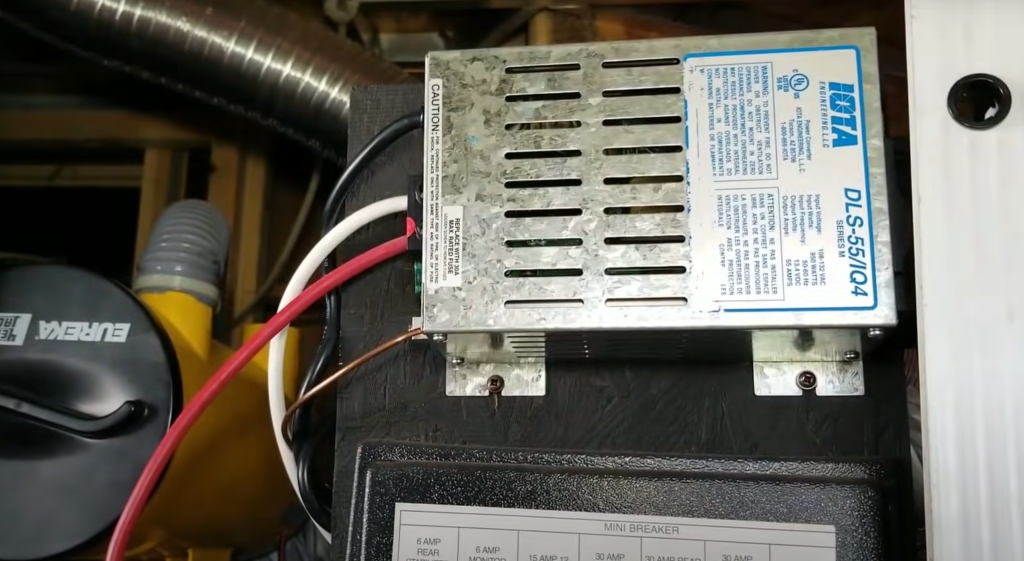
It’s also important to consider how long the battery needs to be charged for before it reaches full capacity. Most RV batteries need at least 8 hours of charging time with a low amp charger (1-10 amps) or 4 hours with a high amp (15-100 amps) charger.
Do RV Batteries Charge When Plugged into Shore Power?
The short answer is yes. The RV’s onboard battery charger will automatically convert the incoming AC current from the campground’s electricity supply to direct current (DC) that can be used to recharge and maintain your RV battery.
You can use solar panels to charge the batteries while you’re out camping, although this method is more common in off-grid situations. If you have access to a generator, it can also be used for charging your batteries during long trips or periods of extended use.
The best way to avoid this is to use a dedicated battery monitor that will keep an eye on the charge level of your batteries while they are being charged.
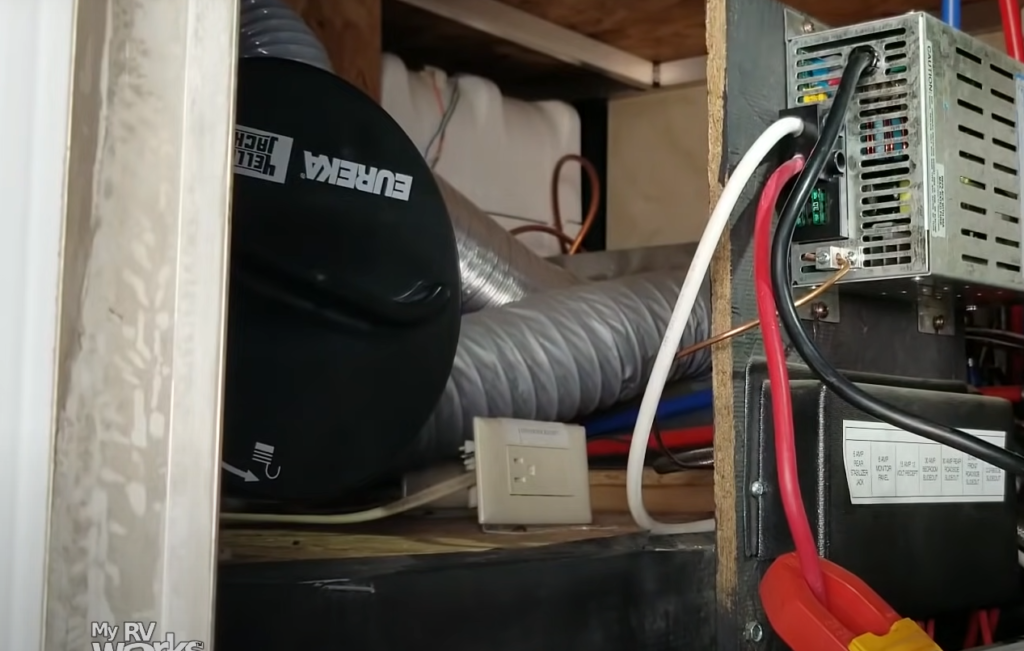
The RV Electrical System
To begin with, the majority of RVs utilize what is known as an ‘alternative current’ power source. This AC power is typically supplied by either 30 A or 50 A circuits from a nearby power outlet.
This AC power allows for different appliances and devices inside the RV to be powered up and operated such as lights, microwaves, televisions, air conditioners and other items that require electricity to run. Beyond this, the energy from an AC power source can also help charge up the battery of an RV if it is connected properly.
12V DC Power
Along with the AC power source discussed above, RVs will also have a 12V DC (direct current) battery supply. This is very important as the majority of appliances and devices inside your RV are actually powered by 12V DC electricity.
So when you turn on lights, microwaves or other such items, they’re drawing energy from this 12V DC power source. This means that in order for these items to work properly, you must ensure that your RV battery has sufficient charge at all times.
To do this, you can either drive your RV for long distances (which helps to keep the battery charged), or make use of an AC-powered charging system which we’ll discuss below.
120V AC Power
As mentioned earlier, your RV needs an AC power source in order to operate different appliances and devices. However, this same AC power can also be used to charge up the 12V DC battery of your RV. This is done by connecting the AC power source to a device known as a converter.
The converter then takes the 120V AC electricity supplied from the nearby outlet and converts it into 12V DC electricity which is stored in the RV’s battery bank. By plugging your RV into a standard AC power source, you can not only provide energy for appliances and devices but also simultaneously charge the battery.
How is the RV Battery Charged on Shore Power?
Once plugged into the mains, your RV’s battery charger will draw electricity from the power outlet and transform it to a charge suitable for your vehicle’s batteries. This charge helps keep the batteries topped up when you are not running the engine or other appliances that might be charging them. The charger will usually have an indicator light to show when it is working properly and providing a charge.
If your batteries are not keeping their charge, then it may be time to check on the condition of your charger and make sure everything looks OK. If there’s something wrong with it, then you can replace it with one specifically designed for RV use. It’s important to get the right type of charger since some regular car chargers may not work correctly with RV batteries.

Another issue to check for is the condition of your cables. If they are in poor condition, then it can prevent any current from flowing through them and charging your batteries. Make sure that all connections are tight, clean, and corrosion-free so that your charger can do its job properly.
Keep in mind that if you leave your RV plugged into shore power for extended periods of time without using it, then it’s possible for batteries to become overcharged due to a faulty battery charger or incorrect settings on the charger itself. To be safe, try not to leave your batteries plugged in for more than a few days at a time unless you’re making sure to monitor them regularly.
Finally, keep in mind that not all RV battery types can be charged on shore power. Some models are designed to only take a charge from the engine or other appliances, so check your owner’s manual first before trying to plug in a charger.
RV Converter / Converter-Charger
In addition to a standard RV battery charger, some units also come with an RV converter. This is a device that takes the AC (alternating current) power from shore power and turns it into DC (direct current) power so that other appliances in your RV can be powered. It does not charge the batteries, but it does provide electricity for things like lighting, air conditioning, and other systems.
The converter may also have a built-in feature called a “converter-charger” which will allow you to both convert AC to DC power and charge your batteries at the same time. This is especially useful if you are trying to conserve energy while plugged into shore power since it can reduce the amount of electricity you need to draw from the outlet.
There are a few important things to keep in mind. Ensure that your charger is working properly and all connections are secure before attempting to charge anything, and be aware of any restrictions on the type of battery you have and whether or not it can accept a charge from shore power. With these tips in mind, you should have no problem keeping your RV’s batteries charged while you’re away!
Other Ways to Charge Your RV Batteries
If you don’t want to rely on your RV’s onboard charging system, you can explore other options for charging your RV batteries. One of the most popular methods is called solar power. Solar panels are installed on top of or beside an RV and they capture energy from the sun and use it to charge the battery. This is a great way to keep your batteries charged in remote areas where there is no access to traditional electricity sources.
Another option is using a portable generator or inverter charger that runs on gas or propane fuel. These devices can be used to recharge your RV’s battery bank without being plugged into shore power. They are perfect for campers who do not have access to a reliable source of electricity while camping.
Finally, many RV owners also use battery-to-battery chargers to keep their batteries charged when they are not hooked up to shore power. This device is installed between two batteries and it acts as a bridge, connecting them together so that the electricity from one can be used to charge the other. It’s an efficient system for those who want to take advantage of the energy stored in their RV’s second battery.
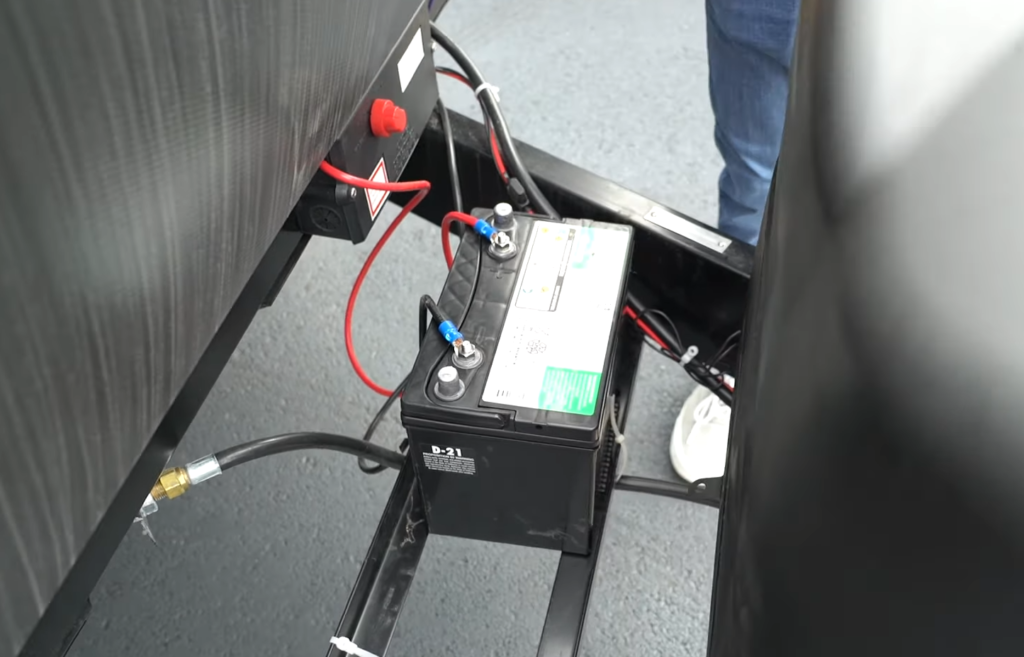
Regardless of which method you choose, being able to recharge your RV’s batteries will ensure that you can enjoy all of the comforts and amenities of home while out on the road!
With a Generator
If you want to charge your RV battery with a generator, there are a few things you should know. To do this, ensure that your generator is compatible with the size of your RV’s battery bank. It’s important to remember that generators provide AC power, which needs to be converted into DC power in order for it to charge the batteries. This is done using an inverter charger (which can be purchased separately).
Once everything is connected appropriately, you can turn on the generator and start charging your RV batteries! Ensure that you follow all safety instructions provided by the manufacturer when operating a portable generator.
Through the Alternator
Another way to charge your RV batteries is through the alternator in your tow vehicle. This can be done while you are driving, allowing your RV battery bank to benefit from the engine’s power output as you drive.
If you don’t have a charging relay installed, there are still ways for you to use your car or truck’s alternator to charge the RV’s batteries. All you need is a “smart” charging system such as an isolator or voltage regulator (both of which can be purchased separately). These devices ensure that the correct amount of current flows
With Solar Power
Using solar power to charge your RV’s batteries is an increasingly popular way to keep them topped off while on the road. Solar panels are typically installed on the roof of the RV or a nearby structure and they convert energy from the sun into electricity that can be used to charge your battery bank.
Installing solar panels and setting up a solar charging system can seem intimidating, but it doesn’t have to be! With a few basic steps, you can easily get started with powering your RV with clean, renewable energy. The first step is determining how much power you need for your RV by calculating its “battery capacity” (the amount of energy stored in its battery bank). Once you know this, you will know what type and size of solar panels to purchase.
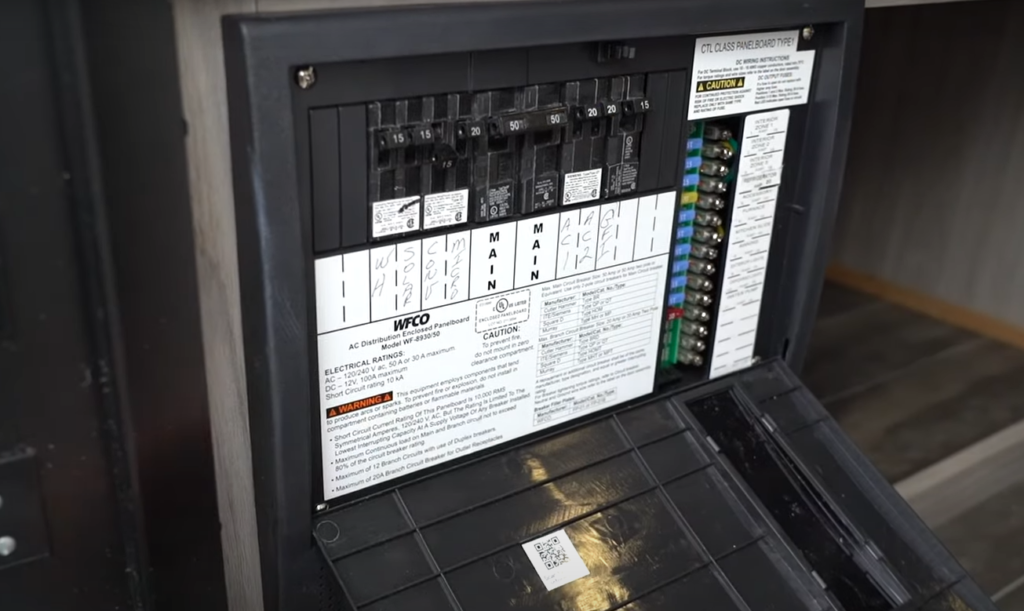
You will also need to get an inverter/charger, a charge controller, mounting brackets and wiring (all of which can be purchased at any auto parts store). After everything is installed correctly, you can enjoy the luxury of charging your RV’s batteries with clean energy from the sun!
Use a Battery Monitor to Prevent Draining Your Batteries Too Far
Using a battery monitor is an important step to ensure your batteries don’t get over-drained. A battery monitor can measure the voltage of your RV’s batteries, as well as how much amperage (or current) is being drawn from them.
A good rule of thumb when charging RV batteries is to charge until the voltage rises above 13.2 volts and then disconnect the charger. Disconnecting it too soon may not give your batteries enough time to recharge fully, while leaving it on for too long can cause damage and shorten the life of your RV’s batteries.
Using a battery monitor will help you keep an eye on their charge level so you know when they need to be recharged or disconnected from the charger. This will help you keep your batteries in good condition and extend their lifespan. [2]
Additionally, a battery monitor can also alert you if there’s been an accidental discharge of power, so you can take action to prevent any further damage.
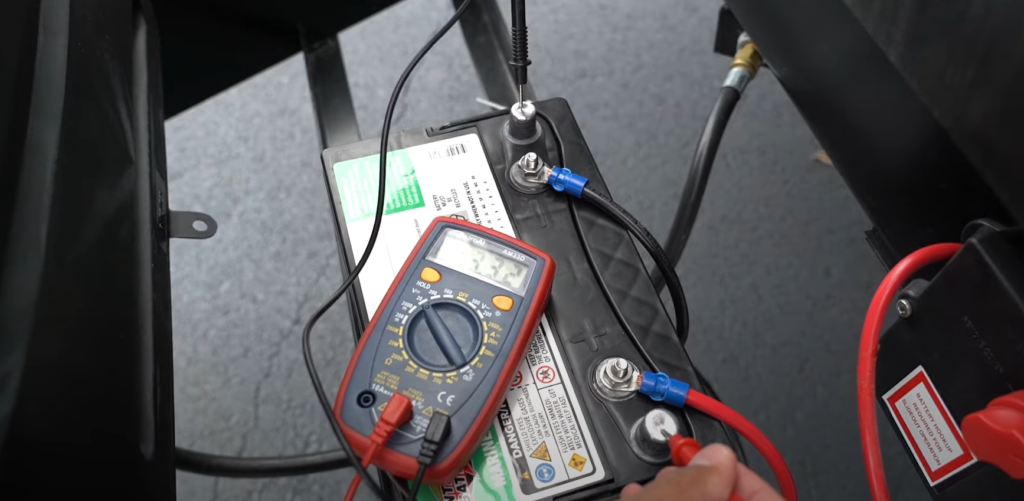
FAQ
How long does it take to charge an RV battery when plugged in?
It depends on the size of your battery and the power of your charger. Generally speaking, it takes anywhere from 6-12 hours to fully charge a 12-volt battery using a standard 10 amp charger. If you have larger batteries or a more powerful charger, then charging time could be shortened significantly. [3]
How does an RV battery get charged?
When you plug your RV into a power source, the battery will charge through a converter/charger. This is essentially an electrical device that transforms AC power from the grid or generator to DC power needed by your RV’s batteries. The charger will maintain the battery at its desired voltage for charging, and when it’s fully charged, it will switch to float mode to avoid overcharging.
If you have solar panels installed on your RV, they can also be used to charge the batteries while you’re out camping. Solar panels are especially useful if you’re boondocking in remote locations where there isn’t access to traditional sources of electricity. Solar energy is free and renewable, so it’s an excellent way to keep your batteries topped up without burning through expensive fuel.
If your RV is equipped with an engine-driven alternator, it can also be used to charge the batteries while you’re driving.
Finally, if you find yourself in a pinch and none of these methods are available, you can always use jumper cables to jumpstart your RV battery from another vehicle’s battery. This should only be done as a last resort however, as it can cause damage to both batteries if not done correctly.
How do I know if my RV battery is charging?
If you’re wondering whether your RV battery is charging, the best way to find out is to check the voltage of the battery with a multimeter. This will show how much energy is in the battery and can help you determine if it’s adequately charged or not. If the voltage reads 12.6V or higher, then your battery is fully charged. If it’s less than 12.6V, then your RV needs some more charging time before you can use it safely again.
You should also take a look at the wiring and connections connected to your RV batteries – make sure they are clean, undamaged and securely attached so that power can reach them properly. Poor wiring and loose connections can cause your RV batteries to not charge correctly. [4]
If you find that your RV battery isn’t charging, it could be time to replace the battery in your RV or repair any electrical issues within your vehicle. If you’re not sure how to do this properly, contact a qualified mechanic or electrician who can help you safely and efficiently diagnose any problems with your RV’s electrical system.
Should I disconnect my RV battery when plugged in?
Absolutely! It’s a good idea to disconnect your RV battery when you’re plugged in, as this will help prevent overcharging and other problems.
When plugged in, your RV’s converter or charger constantly sends energy through the battery, charging it to full capacity. If left connected for long periods of time, the battery could become overcharged – meaning it has received too much power already – which can damage or even destroy the battery.
Ultimately, if you’re intending on parking your RV for an extended period — such as while it’s being stored away — it’s essential to disconnect the battery from its connection. This will also help reduce any risk of short-circuiting that may occur due to electrical faults or other issues.
Also disconnect the battery if you’re about to use your RV for some kind of activity (such as driving) that requires its own power source, such as an engine or generator. This will help ensure that the battery isn’t drained unnecessarily and can remain charged when it is needed. [5]
In short, if you plan on leaving your RV plugged in for extended periods of time – or if you plan on using another power source while driving – make sure to unplug the RV battery from its connection! It may seem like an extra step, but doing so could save you a lot of hassle down the road.
Useful Video: Save Your RV’s Batteries CHEAP & EASY!!
Conclusion
Ultimately, the answer to the question “Do RV batteries charge when plugged in?” is a resounding yes. By making sure that you are using the right equipment and following proper safety guidelines, your RV’s battery can easily be charged while it is still connected to its power source.
When charging your battery this way, make sure to take extra precautions and keep a close eye on everything. It is important to check the voltage of the batteries regularly and never leave them unattended when they are connected to an external charger or AC outlet. Also, be aware that some deep cycle batteries may require slightly different charging procedures than those mentioned here. It is always best to consult with a professional for any specific questions about your model.
Having a reliable battery is essential when taking your RV on the road. Knowing how to safely charge it while it’s connected to power will ensure that your trip goes as smoothly as possible. So get out there and enjoy the open road – just be sure to keep an eye on your charging batteries!
References
- https://rvblogger.com/blog/does-rv-battery-charge-when-plugged-shore-power/
- https://www.thervgeeks.com/do-rv-batteries-charge-when-plugged-into-shore-power/
- https://lifelinebatteries.com/blog/how-long-does-it-take-to-recharge-marine-batteries/
- https://www.rvtravel.com/ask-dave-tell-if-converter-is-charging-1052/
- https://www.thervgeeks.com/should-i-disconnect-my-rv-battery-when-plugged-in/

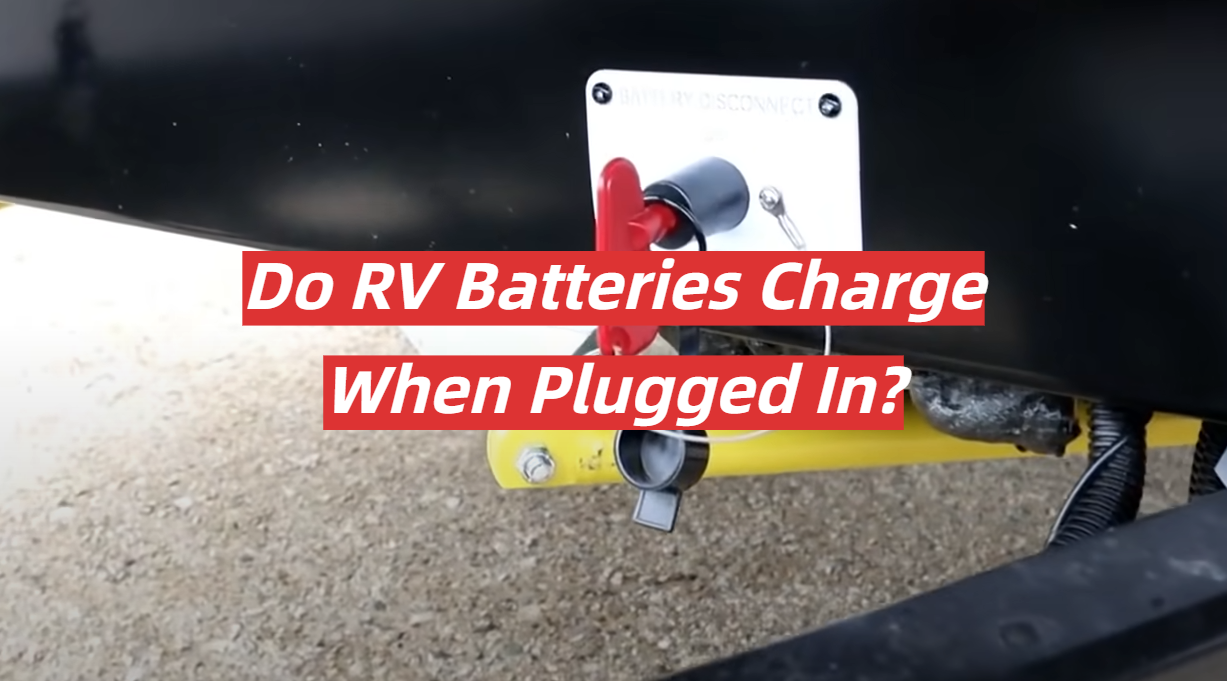

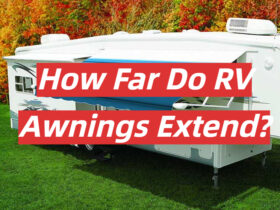
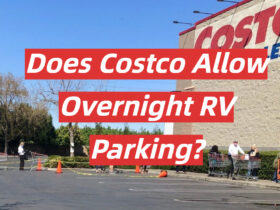

Leave a Reply